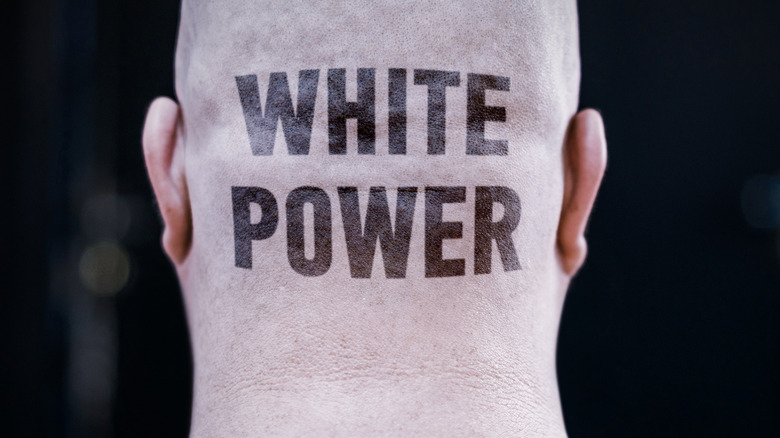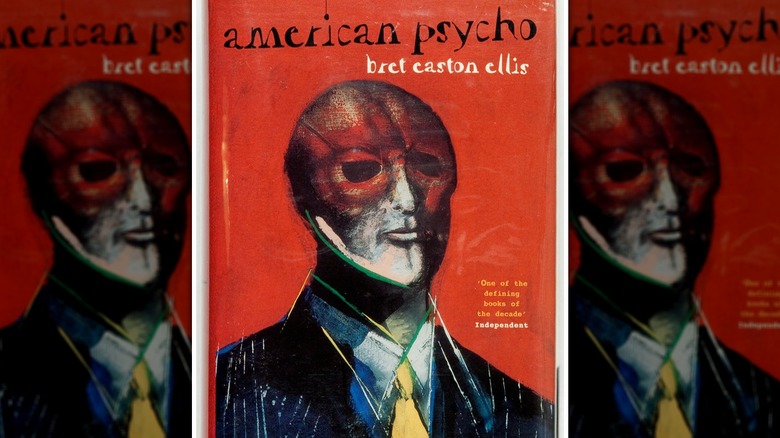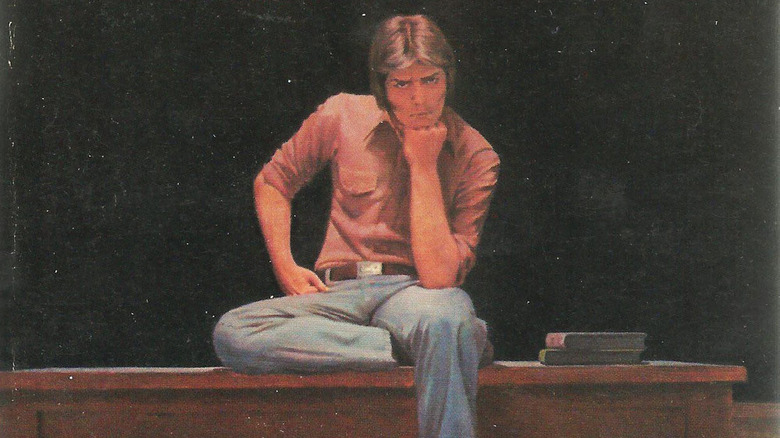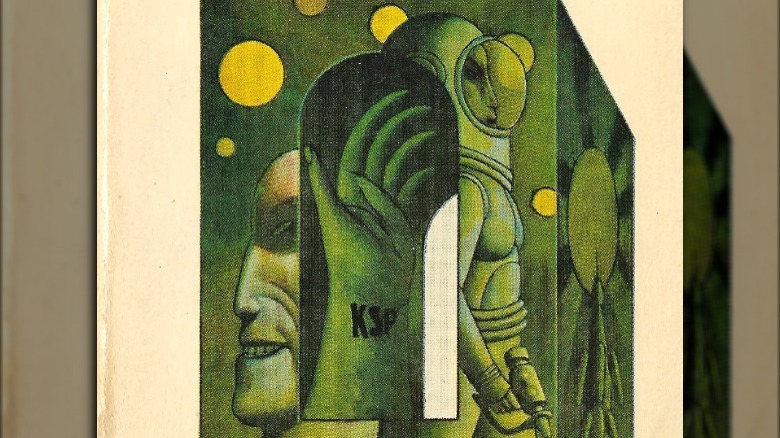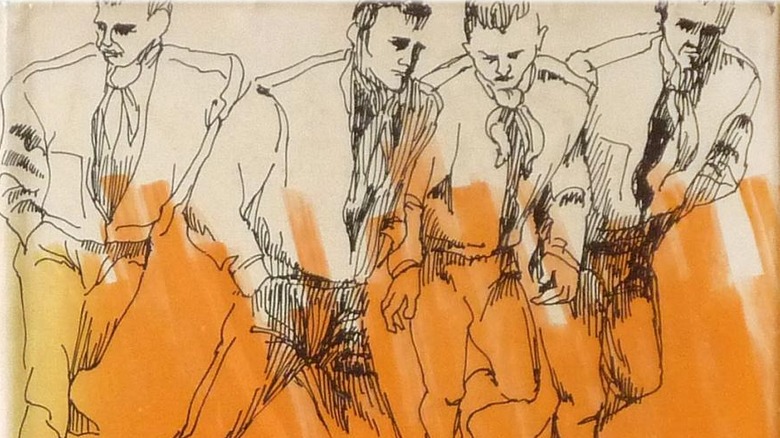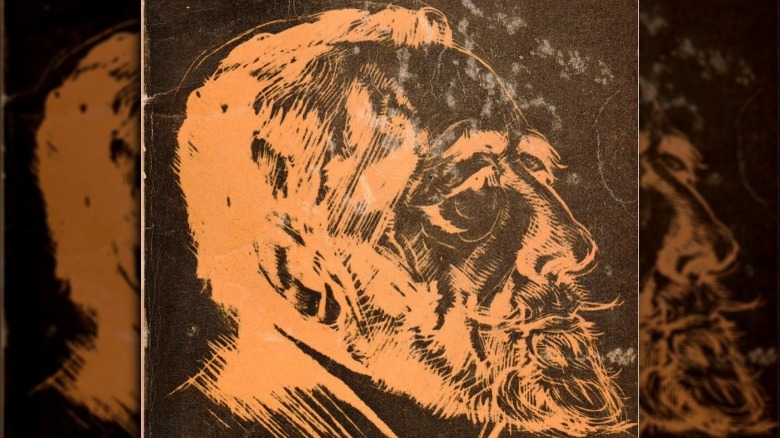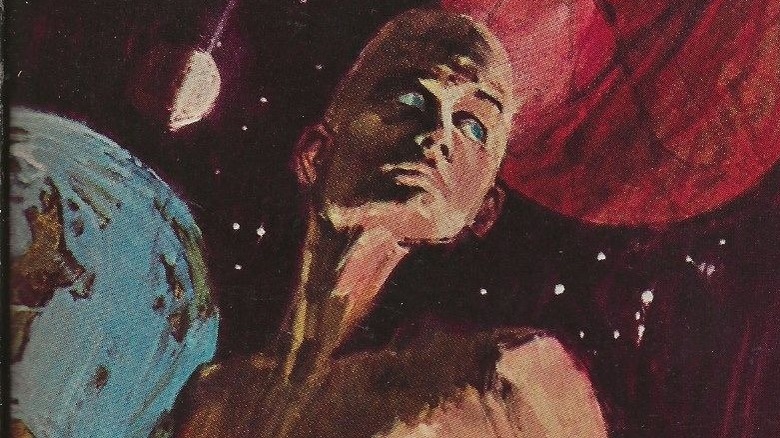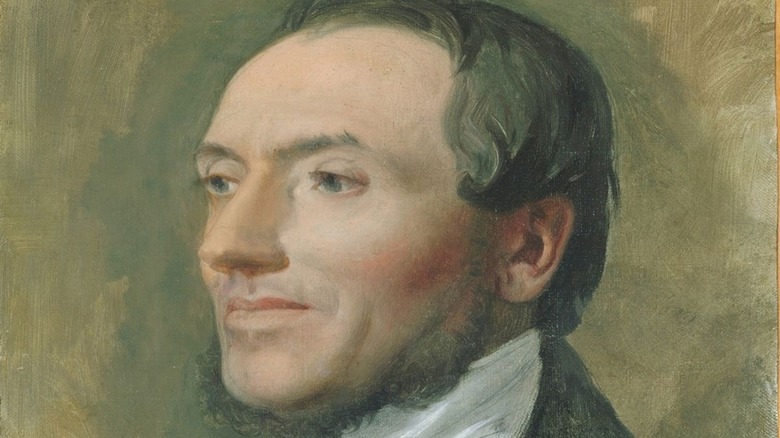Books That Inspired Copycat Crimes In Real Life
We may receive a commission on purchases made from links.
There are few resources as necessary and versatile in the world as books. They store the collective knowledge of humanity — the past, the present, and ideas for the future. They tell stories that shape the way we grow, not just as individuals, but as a species and a society. Ideas and morals are transferred from the author's mind onto the page to be placed into the mind of the reader. They're fascinating, titillating, educating, and, of course, they're easily accessible whether or not the electrical grid is operational.
The stories contained on the pages of our favorite books are often meant to pull at our emotions and put us on mental rollercoaster rides that keep our minds occupied and entertained. There's always something to hold on to or to take away from a book. For many of us, the protagonist or hero of the story can serve as an example. For others, the appeal is in the villainous characters and dark plots. And sometimes, books can serve as inspiration for real-life events, including crimes.
Murder, death, and destruction are brought from the page and made real, and some of these copycat crimes are nearly as famous as the literary works from which they're taken. It is unsettling to learn that a piece of horrifying fiction has been actualized in reality, but the following examples prove it's happened surprisingly often.
The Turner Diaries' legacy of white supremacist violence
In a world where white supremacists have recently increasingly weaseled their way out of the woodwork to wave blazing banners signaling their existence, the influence of William Luther Pierce's 1978 novel "The Turner Diaries" on white supremacist violence becomes all the more pertinent.
The novel is a neo-Nazi's idea of a dystopian future, and according to the New York Times, Pierce ran a neo-Nazi organization. As the Atlantic explains, the story includes Jewish politicians in charge of Black American political foot soldiers who are attempting to confiscate guns in the U.S. The book gets even worse. Sounds hard to do, but it does. A white supremacist insurgency rises up and takes over the world. That's supposed to be the triumphant moment of the novel. As you can see, the whole plot is the perfect wet-dream for white bigots. The Atlantic also reports that the book has inspired more than 200 murders and other crimes, the most famous of which is the Oklahoma City bombing.
The truck bomb that Timothy McVeigh used to kill 168 innocent people in 1995 was something right out of the pages of Pierce's book. Sickeningly, the popularity of "The Turner Diaries" has only grown since it was revealed to have inspired the bomber's actions. It's purely white supremacist propaganda, and despite Amazon removing the book from its online shop in 2021, the book is still widely available.
Rurik Jutting's murders were right out of American Psycho
Bret Easton Ellis's "American Psycho" is definitely a violent book, but has it ever led to real-life crimes? The murders committed by Rurik Jutting were not a result of the book, but the killer certainly saw himself in its pages.
When Jutting was found guilty of his crimes, the media was quick to attach the "real American Psycho" moniker to his name, which makes sense given his actions. According to one of Jutting's old school friends (via the Sun), "American Psycho" was Jutting's favorite book. On top of that, he idolized Patrick Bateman, the Wall Street murderer-psychopath main character, to the point where the former friend believes he was trying to "model himself on Bateman."
Jutting worked in finance, and he also had at least a fraction of Bateman's violent psychosis. As the Inquisitor explains, the real-life killer admitted to murdering two women in Hong Kong, allegedly luring them into his apartment, where he beat them before stabbing them to death. Jutting also said he tortured his first victim. If he hadn't been caught when he was, there's a chance he could've gone full "American Psycho" since Jutting said that the murders "felt really good."
The Kansas City Butcher identified with The Collector
In John Fowles's "The Collector," the main character essentially stalks a woman from her teen years into her early 20s. He's obsessed with her, but for a while, he's willing to watch her at a distance. The man is also an avid butterfly collector, and after winning a sizeable sum of money gambling, he devotes his life to adding the girl to his collection. Hence the title of the book. As you can imagine, any copycat crimes involving this book couldn't exactly be minor.
Bob Berdella may have been the serial killer known as the Kansas City Butcher, but he was more than a killer, he was also a twistedly talented kidnapper. His murders seemed to be secondary to his kidnapping in the beginning. He drugged many of his victims, bound them, and kept them around for a while. Sometimes for weeks, according to All Thats's Interesting. He beat and tortured them too, which accidentally led to the death of his first victim. Berdella reportedly only murdered his second because he thought he was about to be found out.
But why did kidnapping play such a large role? When the Kansas City Butcher was questioned about the influences between his dark crimes, he claimed that it all started when he saw the movie adaptation of "The Collector" when he was a teenager.
Stephen King pulled Rage because it inspired too many copycats
School shootings happen terrifyingly often in the U.S. The idea of someone unleashing that level of horror, pain, and death on youthful innocents who've yet to experience or learn about life is enough to scar the mind. It's one of the truest forms of evil, which is likely why it was the subject of Stephen King's short book "Rage." He is, after all, one of the grandmasters of horror and literary creators of unimaginable evil.
When King wrote his book under a pseudonym back in 1965, school shootings weren't such an unfortunately popular phenomenon. Same goes for when it was published in the '70s. The story follows a mentally ill high school kid who one day shoots up his school and holds one of his classes hostage. According to Business Insider, there were at least four situations through the '80s and '90s where students held their classes hostage or shot other students and school staff with connections to King's "Rage". Sometimes these incidents turned deadly. Other times, the gunmen gave up, but they were connected.
King isn't the type of guy to brush off crimes that may have been inspired by his work, and in 1997, a copy of the book was found in the locker of a 14-year-old Kentucky student who killed and wounded several school peers, according to the Guardian. King had the book pulled from print right after.
Sci-fi that inspired a Japanese doomsday terrorist cult
In 2018, Shoko Asahara and other members of a doomsday cult known as Aum Shinrikyo were executed by the Japanese state for perpetrating the worst terrorist attack to ever happen in Japan, according to The Strategist. As History explains, the attack took place in the Tokyo subway system in 1995, when Aum Shinrikyo set off sarin gas delivery devices, injuring more than 5,000 innocent people and killing 12. The terrorist cult's roots came from a sci-fi novel series written by the great Isaac Asimov.
Probably one of Asimov's more famous works, the "Foundation" series speaks of a hero who forms a secret society meant to rebuild the human world after a foretold total collapse of the fictional intergalactic civilization. The secret society, as Wired notes, becomes a religion after the protagonist dies. Asahara took the pages to heart and formed his own secret-society-turned-religion, which in the real world equates to a cult. The series became Asahara's blueprint, but in his organization's attempt to "save" as many humans as possible from a fictional apocalypse it believed to be real, the cult members committed the worst civilian crime known to the country.
Aum Shinrikyo wasn't a small group either. It had around 100 active and former military personnel, as well as several scientists and doctors. It's amazing what cult leaders are capable of, especially when they're armed with a classic piece of sci-fi excellence.
A Clockwork Orange inspired the murder of a woman
"A Clockwork Orange" is filled with a level of violence that was shocking at the book's 1962 release, and remains so today. The film adaptation that followed in the early '70s brought the dystopian world of "ultraviolence" to a wider audience, and there has been at least one violent incident inspired by this franchise, as well as several crimes that could have been straight out of the story. That said, copycat crimes haven't been as plentiful as the early critics believed it would be, as "Clockwork Crimes" points out. However, the early reaction was so strong that director Stanley Kubrick pulled the movie from circulation, according to The Vintage News. Unfortunately, that wouldn't stop violence associated with the story from taking place entirely.
In 2005, a gang obsessed with "A Clockwork Orange" wreaked havoc in Barcelona. According to The Times, they copied the gang from the story, who were known for their unbridled violence. The real-life gang attacked homeless people in the streets and, at one point, lit a woman on fire while she was sleeping, killing her. If you haven't read the book or seen the film, these types of attacks would fit perfectly within the story, which sounds like what the Barcelona gang was going for.
The Basketball Diaries may have inspired multiple shooters
Jim Carroll (pictured) was an all-round creative genius of sorts. He was a poet, a punk rock musician, an author, and more. "The Basketball Diaries" is a memoir of Carroll's hoodlum youth and how it overlapped with his young sports career. There's a lot of petty crime in the book, which surely may have inspired some kid already on the edge to snatch a purse or start hitting the hard stuff, but it was the movie adaptation that inspired the worst copycat crimes.
In both the film and novel, there's a dream sequence in which Carroll takes a long gun, bursts through his school door, and shoots up his English class. Out of all the crimes copycats could have chosen, this is the one they seem to latch ahold of. In 1997, according to Denver University's Law Review, a 14-year-old boy stole several firearms from a friend's house, lugged them to school the following day, and gunned down a school prayer group. He killed three students. Afterward, he claimed the scene in "The Basketball Diaries" to be his inspiration behind the crime.
A more notorious case inspired by the book is the Columbine School Massacre, which took place in 1999 and which "Criminal Behavior and the Copycat Effect" claims was inspired by the same scene.
One man took The Vampire Chronicles to heart
When we think of books inspiring copycat crimes, we usually picture crimes that are possible in our world, not the worlds of monsters and creatures of the night. We don't expect a man to go full-on vampire from reading a few vampire stories, but that is exactly what happened to Allan Menzies of Scotland in 2003. Unfortunately for Mr. Menzies, vampires in our world don't come equipped with superpowers and immortality.
Menzies thought he was being granted immortal life from a blood-sucking protagonist of Anne Rice's "The Vampire Chronicles," but in reality this was simply a case of murder and cannibalism, as the Irish Times explains. Menzies beat his friend's head in with a hammer and stabbed him multiple times. He then drank his blood and "ate a bit of his head," as he confessed to an officer. He was obsessed with Anne Rice's work, telling the court at his trial that he'd been instructed to perform the murder at the behest of Akasha (via the Guardian). Multiple books from the series were found in his home with annotations in the margins, including the words "The blood is the life, I have drunk the blood and it shall be mine, for I have seen horror."
Psychiatrists determined that Menzies was suffering from a psychopathic disorder, but that this was not grounds for diminished responsibility in his trial. The BBC reports that the killer was sentenced to life in prison, which would be quite a long time for the undead. However, being mortal, Menzies died in his prison cell in 2004.
The Unabomber had a passion for Conrad's The Secret Agent
The Unabomber, Ted Kaczynski, created a mess of terror throughout the late '70s and '80s when, as the FBI notes, he set off 16 bombs that killed a total of three people. He placed some in strategic locations, and mailed others as packages to victims. The bomber was meticulous when it came to covering his tracks, and though the investigation that would eventually bring him to justice began in 1978, this terrorist wasn't caught until 1996.
The authorities believe that Kaczynski was likely drawing inspiration from the novel "The Secret Agent" by Joseph Conrad, according to the Washington Post. To start with, he loved the novel, as well as other Conrad fictions, and had read it near a dozen times. There were striking similarities between the way Kaczynski and the book's protagonist led their lives — isolated, removed from society, and with a view of science as a false idol. Kaczynski specifically targeted scientists and experts in the field of technology. He conspicuously opposed advancing technology in the taunting letters he sent to the media. Both the character from "The Secret Agent" and Kaczynski also chose explosives as their weapons. There are several other nuanced similarities that support the conclusion that the Unabomber's crimes were inspired by the story.
Charles Manson is thought to have been obsessed with a Heinlein novel
There's a lot of speculation about whether or not Charles Manson was drawing from Robert Heinlein's novel "Stranger in a Strange Land" or not. Manson said that had never read the novel because reading books was a boring affair (via the Los Angeles Times), but the last people who took Manson's word for anything ended up in a heap of trouble.
Heinlein's novel describes a messiah-type who was born on Mars by humans on an expedition, then raised by an alien race. He comes back to Earth and preaches the ideals of his Martian culture once he discovers the two planets are nothing alike. What does he preach? To sum it up: free love. Sound familiar?
The Mars-born man develops a religion with facets that the New Republic says the Manson Family adopted. Looking at the murderous cult through the lens of obsession with "Stranger in a Strange Land" sure makes a few things stand out. Manson brought his followers together with the same "free love," and the cult adopted rituals and terminology straight out of the book that Manson supposedly never read. The followers were promised superhuman powers like the book's protagonist possessed. When one of the cult members was in trouble for attempting to assassinate Gerald Ford, he even called Heinlein to ask for help.
Since there's no definitive evidence, it's not certain, but there's a chance that the entire Manson Family cult was inspired by Heinlein's work.
Jack Sheppard brought dozens of copycats out in Victorian London
Copycat crimes might seem like a thing of the modern era, or at least the past hundred years or so. Before that, there just wasn't as much material to draw from. Nor was there the level of access to information about true and fictional crimes that we enjoy now. Even if there were centuries-old copycats, records of those copycat crimes and their originals would have had to survive through the ages for us to know about them. That said, there is at least one example. It doesn't go as far back as you may have hoped, but William Harrison Ainsworth's "Jack Sheppard" caused dozens of copycats in Victorian-era London, according to Publishers Weekly.
In 1839, the best-selling novel "Jack Sheppard" was quickly turned into a stageplay, which helped the frenzy surrounding the content spread through the city. The subject of the story was a romanticized account of Jack "the Lad" Sheppard's crimes. The man was a famous thief and several-time prison escapee, as Britannica explains. You can see how his story might have a crime or two worth copying. The underclass hero of Jack Sheppard inspired the murder and burglary of an old aristocrat by a servant who was planning to run away and enjoy a life of crime. Publishers Weekly reports that bags of pick-locks and crowbars were sold outside theaters "as a kind of merchandising joke," and that there were "dozens of reported copy-cat 'Jack Sheppard' crimes, in which young offenders either claimed inspiration from the cheeky thief's career, or had the link made for them by magistrates and journalists."

